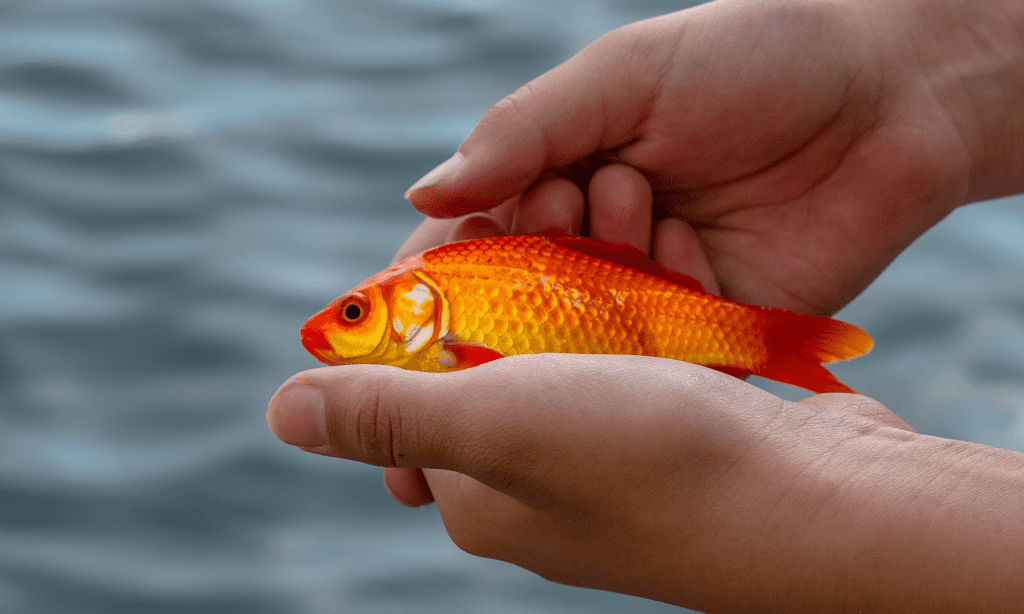As pet owners, we want the best for our furry friends, and that includes providing them with a balanced and healthy diet. It’s only natural for us to wonder about the do’s and don’ts when it comes to our dogs’ nutrition. One question that may cross our minds is, “Can dogs eat real goldfish?” The short answer is no, dogs shouldn’t eat goldfish. In this blog, we’ll explore the potential health risks of feeding goldfish to dogs, drawing on the expertise of a seasoned veterinarian. By being aware of these potential hazards, we can make better decisions when it comes to our dogs’ diet. So, let’s dive into this fishy topic and learn how to keep our beloved pets in tip-top shape.

The Appeal of Goldfish as a Potential Treat for Dogs
Goldfish, with their vibrant colors and fascinating movements, can be captivating not just for humans but also for our canine companions. As natural predators, dogs are instinctively drawn to smaller creatures, making goldfish a seemingly appealing treat. Pet owners may be tempted to indulge their dogs’ curiosity and consider feeding goldfish as a unique snack. The appeal of goldfish as a potential treat for dogs is primarily driven by the following factors:
- Natural instincts: Dogs, being descendants of wolves, have an innate predatory instinct. They are naturally attracted to smaller animals like goldfish, which may trigger their hunting drive. This inclination can make goldfish appear as an enticing treat for dogs.
- Novelty: Pet owners often seek to provide variety in their dogs’ diet to keep them engaged and happy. The idea of feeding goldfish to dogs may stem from a desire to offer them a new and interesting experience. This novelty could be appealing for both the pet and the owner.
- Nutritional considerations: Some pet owners might assume that feeding their dogs real goldfish can provide nutritional benefits, such as protein and essential fatty acids. These nutrients are important for maintaining a dog’s overall health. The idea of offering goldfish as a treat might seem reasonable.
However, despite these appealing factors, it’s important to consider the potential health risks associated with feeding goldfish to dogs. As we delve further into this topic, we’ll consult an expert veterinarian to shed light on these concerns and provide guidance on safer treat options for our canine companions.

Health Risk #1: Bacterial Infections
Feeding goldfish to dogs may expose them to harmful bacteria, posing a significant health risk. Live or dead goldfish can carry a variety of bacteria that, when ingested by dogs, can lead to various health problems. Let’s take a closer look at this risk and its potential consequences:
- Sources of bacteria: Goldfish, especially those kept in aquariums or ponds, can be exposed to numerous types of bacteria. These bacteria may thrive in the water, on surfaces, or even within the goldfish themselves. When a dog consumes a goldfish, these bacteria can be ingested as well, potentially causing illness.
- Consequences of bacterial infections: When dogs consume bacteria-contaminated goldfish, they may develop a range of health issues, including:
- Gastrointestinal problems: Ingesting harmful bacteria can lead to diarrhea, vomiting, and abdominal pain in dogs. Severe cases may result in dehydration or even life-threatening complications, requiring immediate veterinary care.
- Systemic infections: In some cases, the bacteria from the goldfish can enter a dog’s bloodstream, causing a systemic infection. These infections can affect multiple organs and may require aggressive treatment, such as antibiotics or supportive care.
To prevent bacterial infections, our expert veterinarian advises against feeding goldfish to dogs. Instead, they recommend providing your dog with treats and food specifically designed for canines, which undergo strict quality control and are less likely to harbor harmful bacteria. Additionally, pet owners should consult their veterinarian for personalized advice on dog nutrition and safe treat options.
Health Risk #2: Parasites
Another significant health risk associated with feeding goldfish to dogs is the potential transmission of parasites. Goldfish, like many other aquatic animals, can harbor various parasites that could infect dogs upon ingestion. Here’s an overview of this risk and its potential impact on a dog’s health:
- Types of parasites: Goldfish can be carriers of both internal and external parasites. Some common parasites found in goldfish include protozoans, trematodes (flukes), and nematodes (roundworms). When a dog consumes an infected goldfish, these parasites can be transmitted to the dog, leading to parasitic infections.
- Consequences of parasitic infections: Ingesting parasites from goldfish can result in various health issues for dogs, such as:
- Internal parasitic infections: When dogs consume parasites through infected goldfish, these parasites can invade their gastrointestinal tract, causing symptoms like diarrhea, vomiting, weight loss, and poor coat condition. In some cases, internal parasites can lead to more severe complications, such as anemia or damage to vital organs.
- Compromised immune system: A dog infected with parasites may have a weakened immune system, making them more susceptible to other infections and diseases. This can be particularly concerning for puppies, senior dogs, and dogs with pre-existing health conditions.
To minimize the risk of parasite transmission, our expert veterinarian strongly advises against feeding goldfish to dogs. Instead, they recommend providing your dog with high-quality, parasite-free dog treats and food designed specifically for canines. Regular veterinary check-ups and parasite prevention measures, such as deworming, are also essential for maintaining your dog’s overall health and well-being.

Health Risk #3: Choking Hazard and Injury
Feeding goldfish to dogs also poses a choking hazard and a risk of internal injury. The size, shape, and bones of goldfish can create potential dangers for dogs when consumed. Here’s a closer look at this risk and its implications:
- Choking hazard: Goldfish, depending on their size, can be a choking risk for dogs, especially smaller breeds. When a dog attempts to swallow a goldfish whole, it can become lodged in their throat, obstructing the airway and potentially leading to a life-threatening situation.
- Internal injury: Even if a dog successfully swallows a goldfish, there’s still a risk of injury. Goldfish have small bones that can cause harm when ingested by a dog. These bones can puncture or become lodged in a dog’s gastrointestinal tract, causing pain, inflammation, and even life-threatening complications that may require surgical intervention.
- Factors contributing to choking hazards and internal injury:
- Dog’s size and breed: Smaller dogs are at a higher risk of choking on goldfish due to their smaller airways and gastrointestinal tracts. However, larger dogs can also face potential hazards when consuming goldfish.
- Dog’s eating habits: Some dogs may try to swallow food quickly without properly chewing, increasing the risk of choking or internal injury when eating goldfish.
To minimize the risk of choking and injury, our expert veterinarian recommends avoiding feeding goldfish to dogs altogether. Instead, they suggest offering your canine companion safer treat options, such as high-quality commercial dog treats or homemade snacks made from dog-friendly ingredients. It’s essential to consult your veterinarian for personalized advice on suitable treats and feeding practices to ensure your dog’s safety and overall well-being.
Alternatives to Feeding Goldfish to Dogs
Given the health risks associated with feeding goldfish to dogs, it’s essential to explore safer and more appropriate treat options for our canine companions. Here are some healthier alternatives to consider when looking for ways to spoil your dog while ensuring their safety and well-being:
- Nutritious commercial dog treats: There is a wide range of high-quality commercial dog treats available on the market, designed specifically for canine consumption. These treats typically undergo strict quality control and are formulated with dog-friendly ingredients. When selecting commercial treats, look for products with natural ingredients and minimal additives. It’s also important to choose treats appropriate for your dog’s size, breed, and dietary requirements.
- Homemade dog treat recipes: Make homemade dog treats for control over ingredients, safety, and nutrition of your furry friend’s snacks. Some popular dog-friendly ingredients include lean meats, fish (deboned and cooked), fruits (such as apples and blueberries), and vegetables (like carrots and green beans).
- Interactive feeding toys: To provide mental stimulation and satisfy your dog’s natural instincts, consider using interactive feeding toys. These toys dispense treats or kibble as your dog plays, providing both physical and mental exercise. This can be a great alternative to live prey, such as goldfish, while still engaging your dog’s natural hunting instincts.
- Training treats: Small, low-calorie training treats can be an excellent option for rewarding good behavior without the health risks associated with feeding goldfish. These treats are specifically designed for frequent use during training sessions, ensuring they won’t contribute to excessive weight gain.
By choosing safer and healthier treat alternatives, you can still spoil your dog while prioritizing their overall health and well-being. Remember to consult your veterinarian for personalized advice on the best treats and feeding practices for your specific dog.

Conclusion
In conclusion, while the idea of feeding goldfish to dogs might seem intriguing, it’s essential to prioritize the health and well-being of our beloved canine companions. As we’ve explored throughout this blog, feeding goldfish to dogs can pose significant health risks, including bacterial infections, parasites, and choking hazards or internal injuries. By understanding these potential dangers, we can make informed decisions when it comes to our dogs’ diet.
Instead of offering goldfish, consider providing your dog with safer, nutritious alternatives like high-quality commercial dog treats or homemade snacks made from dog-friendly ingredients. Engaging your dog with interactive feeding toys can also provide mental stimulation and satisfy their natural instincts without putting their health at risk.
Ultimately, it’s crucial to consult your veterinarian for personalized advice on the best treats and feeding practices for your specific dog. By doing so, you can ensure your dog’s safety, happiness, and overall well-being. So, let’s commit to making informed choices for our furry friends and provide them with a loving and healthy environment in which they can thrive.
~Sheena
